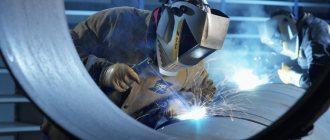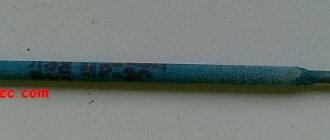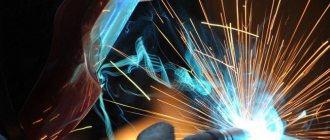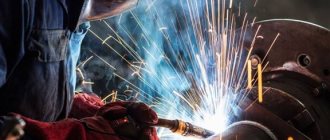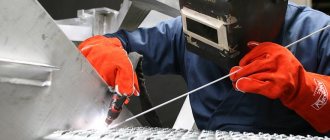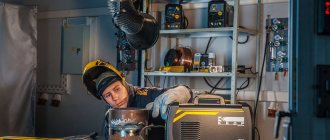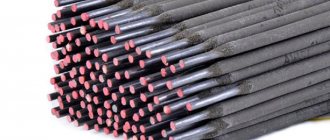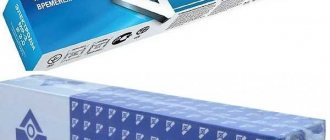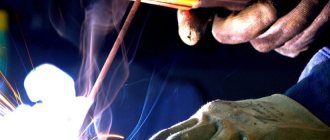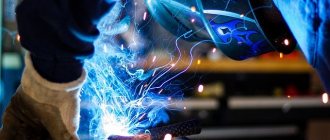The ability to read the electrode markings will help a novice welder choose the right consumables. This skill is necessary for suppliers to select goods purchased for production. The quality of the seam and the cost of the product depend on the correct choice. Let's consider what each letter or number in the marking means, what types of electrodes are available and other details that will be useful in the selection.
- Types of electrodes
- Electrode brands
- Electrode diameter
- Purpose of electrodes
- Coating thickness coefficient
- Index group
- Coverage type
- Spatial position
- Welding current characteristics
Where to find the markings
Marking is necessary to indicate the properties and characteristics of the metal rod and its coating, which affect the arc burning process and the formation of the welding joint. The electrodes themselves are produced in accordance with GOST 9466-75 and GOST 9467-75 and are necessarily marked so that the user can look at the designation and understand how best to use welding materials.
Labeling must be applied to the packaging. The inscription is placed on a white or blue field, free from the decorative design of the pack. Markings are also applied to the melting coating, closer to the end of the electrode inserted into the holder. Some manufacturers additionally indicate data on the side of the pack, but this is not a requirement.
Types of coatings for electrodes
Along with the material of manufacture and purpose, the type of electrode coating is also selected. The choice of coating also depends on the metal being welded. The coating (or coating) performs a protective function. When the electrode melts, the coating releases protective substances and slag, which improves the quality of the seam and produces reliable and durable welded joints. Manufacturers use the following types of electrode coatings:
- Acid coating. Marked with the letter “A” on the packaging and the electrode itself. Used for highly targeted applications, such as bottom welds. Can be used with both AC and DC current.
- Rutile coating. Marked with the letter "P". One of the most popular coatings among both beginners and professionals. Compared to other coatings, it is almost non-toxic and provides good quality seams. When burned, it forms slag with protective properties. The composition can be varied, but the base is always titanium dioxide or simply rutile. Hence the name.
- Cellulose coating. Marked with the letter "C". Suitable for making any welded joints, ensures good quality of the seam, but at the same time contributes to strong metal spattering. We recommend using cellulose-coated electrodes when welding pipelines, since the disadvantages are not critical in such work.
- Basic coating. Denoted by the letter "B". The most popular type of coating along with rutile. Simulates gas welding due to the release of carbon dioxide when the arc burns. We recommend using base coated rods only in combination with direct current and reverse polarity. If you use alternating current, the weld will be of poor quality and additional measures will be required to improve the strength of the seam.
- Other types of coatings. Marked with the letter "P". The composition contains alloying substances. Thanks to this, the quality of the seam improves. In general, other types of coatings are used the least often.
- Special types of coatings. They are designated by the letter “C” or the inscription “special” on the packaging. They are used for complex welding under water, since they contain liquid glass and resin-containing substances.
As you can see, electrodes are selected based on specific tasks. For manual arc welding, rutile-coated rods are most often used because they are universal.
Types of electrodes
E42A
-UONI-13/45-3.0-UD ———————————— E432(5)-B 1 0
The marking consists of a group of letters and numbers, behind which there are certain characteristics. For clarity of explanation, let’s take as an example common electrodes with the following markings:
The first indices E42A indicate the type of consumable element. There are several of them and they explain to the welder which metal is best welded with certain electrodes.
| Surfacing of the surface layer of metal | E-10, E-10G3, E-12G4, E-15G5, E-16G2ХМ, E-30G2ХМ - in total there are 38 types of this group |
| Welding structural carbon and low alloy steel | E38, E42, E46, E50, E55, E60 |
| Welding of carbon and low-alloy steels with increased requirements for impact strength and weld ductility | E42A, E46A, E50A |
| Welding of alloy structural steels | E70, E85, E100, E125, E150 |
| Welding of high-alloy structural steels | E-12X13, E-06X13N, E-10X17T, E-12X11NMF, E-12X11NVMF |
| Welding heat resistant steel | E-09M, E-09MH, E-09X1M, E-05X2M, E-09X2M1, E-09X1MF, E-10X1MNBF, E-10X3M1BF, E10X5MF |
In our example, type E42A is indicated, where:
- E - electrodes for RDS.
- The number 42 is the tensile strength, measured in kg per mm?.
- A - the weld metal will have increased ductility and impact strength.
Thanks to knowledge of this part of the marking, you can easily select electrodes based on the strength of the seam - the higher the number, the stronger the connection. For example, in our case, 42 means that the welded seam will withstand a load of 42 kg per 1 square millimeter. When resistance to sudden loads is required, choose consumables with the prefix “A” in the type.
Seam type and electrode selection
It is quite logical that the selection of components for the RDS should be carried out in accordance with the connection. Metal and seam play a big role in this matter. There are regular seams: vertical, horizontal, and also inclined.
In addition to this division, there are also butt, oblique, and beveled seams. This information will be useful for both beginners and professionals with 15 years of experience. It is worth dwelling on what brands of welding rods exist in 2022.
Electrodes are distinguished by brand in the case of manual arc welding. This fact also depends on what metal you need to work with. The data is displayed in the table.
Electrode brands
E42A- UONI-13/45
-3.0-UD ———————————— E432(5)-B 1 0
The brand is determined by GOST or patented separately by the manufacturer if its designation differs from generally accepted standards. Indicates the purpose of the consumables. Among the standard brands according to GOST there are the following:
- ANO-4, -6, -17, -21, -24, -36, -37, -27, UONI 13/45, 13/55, MR-3, -5, TMU-21U, VN-48 - for welding low-alloy and carbon steels.
- OZL-6, -8, -17U, -9A, -25B, ZIO-8, ANZHR-3U, -13, NII-48G - for welding high-alloy steel.
- TsCh-4, MNCh-2 - for welding cast iron.
- T-590, -620, -6L, -12M, EN-60M, OZN-400 - for surfacing the surface layer.
- TsM-7S, OK-46, ANO-1, OZS-3, OZS-12 - for underwater welding.
Some manufacturers have created their own brands of electrodes for all these processes and patented the designations. The most common is OK from ESAB.
Which brand of welding electrode should I choose?
Products from both foreign and Russian companies show high performance. The most common brands of welding electrodes have a large number of positive reviews among professional and novice welders. The most popular companies producing electrodes with basic and rutile coating:
- SSSI. The product UONI 13/55 has a basic coating, has an affordable price, and provides a reliable seam. Moreover, it is affordable and popular, so it can be easily purchased from any relevant store.
- Kobelco. Products from this company also have a base coating and require pre-calcination to remove excess moisture. Suitable for welding pipes and serious structures.
- ESAB-SVEL. The equipment of this company does not require serious calcination, since it is not highly sensitive to moisture. Work can be carried out at a minimum current, which allows you to work with thin-walled steel.
- Lincoln Electric. The electrodes from this company are inexpensive, have fast ignition, and form a high-strength seam.
- OZL-8. Electrodes for welding stainless steel, as well as metals containing chromium and nickel. They are distinguished by their high cost.
- Resanta MP-3. If this product becomes damp, prolonged calcination at medium temperature will be required, otherwise the quality of the seam will noticeably drop.
In addition to popular brands of electrodes, there is a variety of welding elements that have a narrow scope and are not used in everyday life.
In general, it is worth noting that the quality of the seam formed, the speed of the process, safety and comfort of work depend on the parameters and characteristics of the selected welding electrodes. Reliable equipment guarantees reliable work results, which is why it is necessary to select it carefully and responsibly.
Electrode diameter
E42A-UONI-13/45-3.0
-UD ———————————— E432(5)-B 1 0
The next thing in the marking is the diameter of the metal rod. The value is indicated in millimeters with tenths, separated by commas. The electrode cross-section is selected based on the thickness of the workpieces being welded and the welding current. Electrodes that are too thin will quickly burn and spatter the filler metal, while electrodes that are too thick will create additional resistance and make the welding poor due to the shallow penetration depth.
Selecting the diameter
The seam will not be of high quality if the diameter of the electrode is chosen incorrectly. The thickness of the working part affects the size of the components.
If the core is correct, then all the work will be meaningless without the correct core. To choose an electrode, you need to look at the packaging or the rod.
The diameter has a direct effect on the length of the structure. If you are going to weld at home or in the country, then welding rods with a diameter of 2-4 mm will suit you.
This is a versatile option when you are working with manual arc welding. In addition, the rods are suitable for any metalworking. If the work takes place at a factory, then it is worth taking rods whose thickness is more than 4 mm.
Purpose of electrodes
E42A-UONI-13/45-3.0- U
D ———————————— E432(5)-B 1 0
This is another element that indicates the suitability of certain metals and alloys for welding, as is the case with the type of electrodes:
- B - welding of high-alloy steels.
- T - welding of heat-resistant alloys.
- L - welding of structural steels containing alloying elements.
- N - used only for surfacing.
- U - welding of low-alloy and carbon steels.
Separation of electrodes by application
Depending on what the alloy is made for, the operating mode and electrodes are selected. Different metals require specific components. This is their purpose.
Information is located on the component packaging and on the refill. This is one of the letters:
- “U” – for carbon materials and low-alloy steel;
- “L” – for working with alloyed structures;
- “B” – needed for high-alloy materials;
- “T” – when processing heat-resistant structures;
- “N” - they are used when talking about bases for surfacing.
Coating thickness coefficient
E42A-UONI-13/45-3.0-U D
———————————— E432(5)-B 1 0
Coating is necessary to protect the liquid metal of the weld pool from interaction with the external environment. The coating melts as the arc burns and the rod melts. The thicker the coating, the more protective gas is released. The coating thickness level is indicated in the electrode marking with the letter:
- M - thin.
- C - average.
- G - very thick (maximum possible).
- D - thick.
What is this method
Electrodes for electric arc welding have a great influence on the release of a sufficient amount of heat necessary to melt the metal of the welded products, so their correct selection and proper use play a big role.
An electrode is a metal rod coated on the outside with a coating that is a special composition. During the welding process, the electrode core begins to melt. The metals of the rod and the product, being in a molten state, together form a joint. When burned, the coating releases a gas necessary to protect the welding zone from the negative influence of surrounding oxygen and nitrogen. Electrodes for arc welding solve a number of important problems.
The substances included in the coating have a low ionization potential. The consequence of this is that the arc, after its ignition, is saturated with ions that are in a free state. This stabilizes the arc burning process.
The coating takes part in the formation of slag on top of the weld, which reduces the rate at which the molten metal cools. This creates good conditions for removing impurities and non-metallic inclusions from the seam, which impair the quality of the joint.
Electrode coatings contain deoxidizers whose job is to react with oxygen, causing it to bind. With the help of electrodes, the metal forming the weld is alloyed, which improves its properties. This is ensured by substances included in the coating, such as silicon, chromium, manganese, and titanium.
Index group
Sometimes the marking contains an additional designation written under the horizontal line.
E42A-UONI-13/45-3.0-UD ———————————— E432(5)
-B 1 0
Digit 4
indicates the resistance of the weld to corrosion. There are five levels in total (0/2/3/4/5) - the higher the number, the better. In our example, the number is 4, which indicates high protection of the seam from rust during subsequent use.
Digit 3
refers to the maximum temperature at which the heat resistance of a joint is maintained. There are 9 options in total, where 1 is 500 degrees, and 9 is over 850 degrees. In our case 3 - the seam will withstand heating up to 560-600? With no loss of properties.
Digit 2
— limit of working temperature of the seam. It also has 9 levels with an indicator from 600 to 1100 degrees. In our example, 2 indicates a limit of 650? C, after which changes will begin in the metal.
The value taken in brackets (5) is the amount of ferrite phase in the weld. The index is divided into 8 levels with percentages from 0.5-4.0% to 10-20%. With our indicator 5, the content of the ferrite phase ranges from 2.0 to 8.0%.
Such a group of indices does not indicate several characteristics at once. Usually, it is written on the packaging of electrodes intended for working with low-alloy and alloyed metals.
Characteristics of manual arc welding
Before we talk about electrodes, you need to understand welding. Manual arc welding is considered a complex process despite its simplicity. An arc is a stream of particles that appear due to ionization of the cathode and anode.
This occurs because the current and the short circuit interact with each other. The welding process depends on the composition of the coating components. It comes from the atmosphere, which excludes its control.
As a result, all processes heat the arch. A large amount of heat is released into the air, which allows the edges of the parts to cook in a minute. After the latter has cooled, the seam is smooth and reliable.
The electrode plays a central role in this matter. If it is not there, the arch will not light and its combustion will not be maintained. Welding is possible when 1 or two electrodes designed for arch work are used.
There is no single division of rods because hand electrodes are divided into subcategories. They differ according to the purpose of welding and the material used in the work.
In addition, electrodes can be made of alloys other than metal.
Coverage type
E42A-UONI-13/45-3.0-UD ———————————— E
432(5)-
B
1 0
The letter E at the beginning of the second line of marking indicates a consumable electrode, the coating of which burns out from the temperature of the electric arc. But the type of coating is indicated by the letter B. There are four main options, as well as their mixing with each other:
- A - this is the designation for acidic coating. Electrodes with this marking are manufactured for work in all spatial positions on direct and alternating current. But they cook poorly from top to bottom. Not suitable for joining metals with a high carbon and sulfur content; they promote splashing of droplets and may cause cracks in the seam.
- B is the main coating designed for welding with direct current of reverse polarity. Suitable for joining thick workpieces.
- P - designation for rutile coating. Electrodes can work on alternating or direct current in any spatial position, but verticals from top to bottom are difficult.
- C - cellulose coating. Consumables are used for the installation of metal structures; they are excellent for welding in all positions in space on direct and alternating current. But there are increased losses due to splashing.
- RB, AC - mixed coating options. Optimal for welding in the lower and vertical positions of pipelines. Provide low consumption.
In order for the electrode to correspond to the markings, its coating must contain chemicals in certain proportions. These can be: quartz sand, kaolin, marble, manganese ore, titanium concentrate, chalk, etc. It is the gas from the molten coating that reacts with the weld pool and gives the seam certain characteristics. This process occurs during the burning of the arc and after its extinction, while a new crystal lattice is formed.
Brief classification of electrodes
As we wrote above, it is difficult to classify electrodes according to only one parameter. But basically, all rods are primarily divided by the type of material from which they are made, as well as by coating (or coating). Here is a brief classification of electrodes:
- Melting electrodes. They are made from metal, such as cast iron, aluminum, steel or copper. The material from which the electrode is made is selected in accordance with the metal that needs to be welded. Consumable electrodes are both anode and cathode. This is the most common type of rod at the moment.
- Non-consumable electrodes. Made from coal, graphite or tungsten. They are used in conjunction with welding wire, because such rods are not capable of forming a welding seam. When using carbon rods, use straight polarity instead of reverse polarity. Tungsten rods are indispensable for argon arc welding due to their high melting point, but are rarely used in manual arc welding.
- Electrodes without coating or coating. They are used in conjunction with flux, which is continuously supplied throughout the welding process. For manual arc welding, such rods are not used.
- Coated or coated electrodes. The most common electrodes on the market. The coating of electrodes for manual arc welding performs several functions at once: protects the metal from the negative effects of oxygen, ensures stable arc burning, and improves the quality of the welded joint. Such electrodes are used not only for manual arc welding, but also for semi-automatic and automatic ones.
Spatial position
Indicates for which positions in space the electrodes are intended. Ignoring this part of the marking leads to poor weld penetration, burn-throughs, and increased metal consumption due to splashing and dripping. There are four index options in total:
E42A-UONI-13/45-3.0-UD ———————————— E432(5)-B 1
0
- universal for all positions (as in our example).
- for all positions except vertical top-down.
- optimally cooked horizontally on a vertical surface. Not intended for ceiling welding.
- for bottom corner, tee and regular connections.
